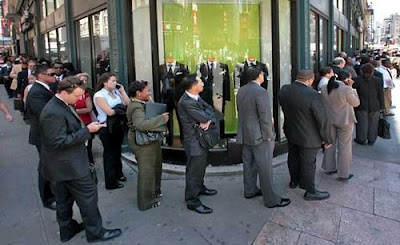Forecasters anticipate the Labor Department to account the financial system added 80,000 jobs in November – considerably less than the 171,000 added the previous month. As budgets talks are moving ahead unsatisfactory jobs reports could possibly persist into the New Year.
Factors contributing to a delay in jobs creation take in temporary displacements caused by Hurricane Sandy and business tensions that President Obama and Congressional Republicans will not reach a negotiation to prevent the fiscal cliff. However, looming larger has been a slowdown in growth of consumer expenses in recent months, and the ongoing nagging effects of the trade inadequacy on economic activity.
The economy have to add more than 349,000 jobs each month for three years to bring down joblessness to 6% and that is not possible with current policies.
Most analysts see the unemployment rate inching up to 8%, while a few see it remaining stable. The wildcard is the number of adults really working or looking for jobs – the measure of the labor force employed to compute the unemployment rate.
Labor force contribution is lower today than when President Obama took office and the healing began, and factoring in discouraged adults and others working part-time that would prefer full-time work, the jobless rate is 14.6%.
Convincing millions of American adults they don’t need or want a job has been Washington’s most effective jobs program, regardless trillions in new stimulus spending, targeted tax cuts, industrial policies and social programs planned to boost demand.
Though Congress may avoid Sequestration, some short-term tax cuts, such as reduced social security payroll taxes and elements of the Bush tax cuts assisting high income families, will possibly descend, and some combination of savings in entitlements and defense spending will be carried out. The package that appears will possibly cut the annual deficit by about $250 billion.
Economists agree that insufficient demand for what Americans make is holding back growth and jobs creation, and President Obama wants $50 billion in new stimulus expenditure. However, the combination of higher taxes, reduced entitlement and domestic spending and some extra public works projects would lessen the budget deficit and domestic demand about $200 billion in 2013.
This would limit GDP growth by about 1 or 2% points, and could lift unemployment to about 10%.
All through the early years of the recovery consumer demand did get bigger as the household deleveraging process ended; however, too many of dollars were spent on imports that did not return to procure U.S. exports – the gap between new imports and new exports was lost demand for U.S. goods and services.
At about $500 billion, the trade shortfall is about entirely attributable to the gaps in trade with China and on oil.
Dealing with China more forcefully about its undervalued currency and other mercantilist practices and opening up more offshore and Alaskan oil reserves for growth could cut the trade shortage in half, jump start strong growth and produce 5 million new jobs, and present the opportunity for considerable deficit reduction.
